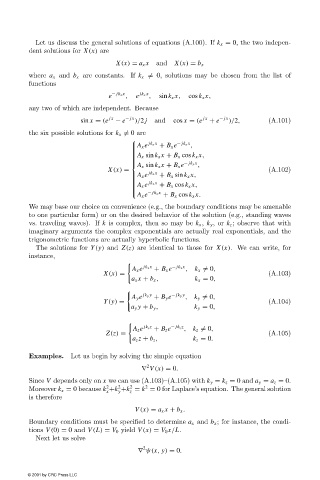Page 496 - Electromagnetics
P. 496
Let us discuss the general solutions of equations (A.100). If k x = 0, the two indepen-
dent solutions for X(x) are
X(x) = a x x and X(x) = b x
where a x and b x are constants. If k x = 0, solutions may be chosen from the list of
functions
e − jk x x , e jk x x , sin k x x, cos k x x,
any two of which are independent. Because
sin x = (e jx − e − jx )/2 j and cos x = (e jx + e − jx )/2, (A.101)
the six possible solutions for k x = 0 are
jk x x − jk x x
A x e + B x e ,
A x sin k x x + B x cos k x x,
A x sin k x x + B x e ,
− jk x x
X(x) = (A.102)
A x e jk x x + B x sin k x x,
jk x x
A x e + B x cos k x x,
A x e + B x cos k x x.
− jk x x
We may base our choice on convenience (e.g., the boundary conditions may be amenable
to one particular form) or on the desired behavior of the solution (e.g., standing waves
vs. traveling waves). If k is complex, then so may be k x , k y ,or k z ; observe that with
imaginary arguments the complex exponentials are actually real exponentials, and the
trigonometric functions are actually hyperbolic functions.
The solutions for Y(y) and Z(z) are identical to those for X(x). We can write, for
instance,
A x e jk x x + B x e − jk x x , k x = 0,
X(x) = (A.103)
a x x + b x , k x = 0,
A y e jk y y + B y e − jk y y , k y = 0,
Y(y) = (A.104)
a y y + b y , k y = 0,
A z e jk z z + B z e − jk z z , k z = 0,
Z(z) = (A.105)
a z z + b z , k z = 0.
Examples. Let us begin by solving the simple equation
2
∇ V (x) = 0.
Since V depends only on x we can use (A.103)–(A.105) with k y = k z = 0 and a y = a z = 0.
2
2
2
2
Moreover k x = 0 because k +k +k = k = 0 for Laplace’s equation. The general solution
x y z
is therefore
V (x) = a x x + b x .
Boundary conditions must be specified to determine a x and b x ; for instance, the condi-
tions V (0) = 0 and V (L) = V 0 yield V (x) = V 0 x/L.
Next let us solve
2
∇ ψ(x, y) = 0.
© 2001 by CRC Press LLC

